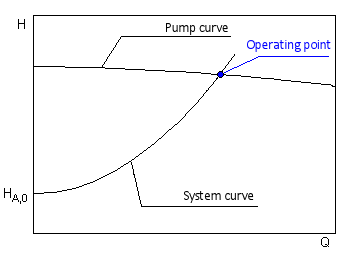 For closed system installations (e.g. heating or cooling circuits), the geodetic head is zero.
For closed system installations (e.g. heating or cooling circuits), the geodetic head is zero.Month: November 2020
Geodetic Head
 For closed system installations (e.g. heating or cooling circuits), the geodetic head is zero.
For closed system installations (e.g. heating or cooling circuits), the geodetic head is zero.Flow
The flow rate for the duty point of a pump is determined from the application, for example for heating systems from the heat requirement calculation or for wastewater systems from statistical parameters for the maximum expected wastewater volume. National and international standards exist for many applications.The performance curves of a centrifugal pump (e.g. head, power consumption, efficiency) are given as a function of the flow.
Head
The head for the duty point of the pump is composed of
- the static head (static = independent of the flow rate)
- height difference between suction side and discharge side liquid level (geodetic head)
- pressure difference between discharge side and suction side tank (for closed tanks)
- the required outlet pressure, if any
- the friction loss head from the pressure losses in the piping system as a function of the flow rate
Vapour Pressure
The vapour pressure of the pumped fluid greatly influences Cavitation Behaviour and thus the System NPSHavailable.The vapour pressure is one of the important liquid properties for pump selection and depends on the fluid temperature.
Operating temperature
The maximum and minimum temperatures of the pumped medium are of particular importance for the design of the pump. They are taken into account in the selection of materials and seals and, if necessary, in a media-material resistance test.The fluid properties (density, viscosity) change with the temperature. The power requirement of the pump is directly proportional to the density. Therefore, the temperature must be taken into account from the operating range with the maximum density. Furthermore, for viscous media (ν > 10 mm²/s), the shape of the pump performance curve must be converted.
Effective Flow
Q = v / AQ – flowv – average flow velocityA – cross-sectional area flowed through
SUMA Rührtechnik GmbH
Operating Point of a Centrifugal Pump
It indicates the values of Flow Q and Head H which will be obtained at stationary operation with the respective speed-related pump H-Q curve.The specified duty point is defined to be that point on the system H-Q curve for which a pump is to be selected in line with the calculated hydraulic design criteria. The objective of the selection is (apart from other criteria, such as maximum efficiency) to minimise the deviation between the specified duty point and the actual operating point.The operating point is always located at the intersection of pump H-Q curve and the actual system H-Q curve. At constant speed it moves up the pump H-Q curve with increasing friction losses towards a lower flow rate. The duty point should be chosen as close as possible to the best efficiency point.
Minimum Inlet Pressure
Pumps require, in order to ensure trouble-free operation, a minimum static inlet pressure at the pump suction port, which is generally termed the minimum available net positive suction head (NPSH).This available inlet pressure decreases with the flow through the pump on account of the velocity change of the liquid in the suction section and the impeller. The critical location is the entry into the impeller suction neck. If the pressure then falls below the operating vapour pressure of the fluid, the fluid flashes into a vapour and forms bubbles.The ensuing flow through the impeller leads to an hydraulic pressure build-up. Within this region the bubbles collapse or implode with a tremendous shock on the adjacent surfaces causing vibration and even destruction in the form of pitting or erosion. This process, termed Cavitation, is accompanied by low rumbling or sharp rattling noise with rising intensity as cavitation increases.The pumping performance is also impaired as the pump is now handling a water/gas mixture. A minimum static inlet pressure must thus be maintained at the pump suction port in order to avoid cavitation.The level of this required pressure depends on:
– the temperature of pumped liquid – required net positive suction head HH (termed: NPSHrequired) corresponding to the pump duty point.
The required net positive suction head (HH or NPSHrequired) relates specifically to the pump and is normally depicted by pump manufacturers as an NPSH curve in the pump duty chart.Generally there is a strong relationship with the pump speed. For constant pump types the following is true:– High speed -> High NPSHrequired – Low speed -> Low NPSHrequired
It is recommended practice to raise these levels by a safety margin of 0,5 m (1,6 ft) to compensate for possible variations on duty point calculations when selecting the pump. General standards allow a minimum level of cavitation at the determined NPSHrequired which:– reduces the Pumping Head at the duty point by 3% or less – does not cause any material deterioration, performance reduction or reduce service life.
Such acceptable levels of cavitation may however cause unacceptable noise.To ensure best performance, it is common practice to load the NPSHavailable calculation with a safety margin of approx. +1 to +5 m (+3 to +15 ft), depending on speed and Duty Point of the pump.
